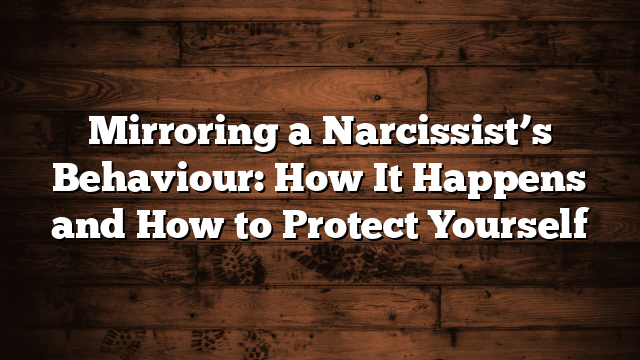Mirroring a Narcissist’s Behaviour: How It Happens and How to Protect Yourself
When dealing with a narcissist, victims often find themselves adopting the very behaviours they once despised. It’s not unusual for people caught in narcissistic relationships to mirror their abuser’s actions as a way to protect themselves, regain control, or attempt to shield their emotional wellbeing. The narcissist’s emotional manipulation, their lack of empathy, and the constant power games they play create an environment where defensive tactics seem like the only option. However, mirroring these behaviours can be a double-edged sword. While it might feel like a way to regain control, it often only escalates the conflict, entrenching the power struggle. Understanding the reasons behind these reactions and the narcissist’s response to them is crucial in learning how to protect oneself and maintain emotional boundaries.
A Narcissists Handbook: The ultimate guide to understanding and overcoming narcissistic and emotional abuse.
Silent Treatments: The Narcissist’s Tool for Control
One of the most common tactics narcissists use is the silent treatment. This manipulative tool is often employed to punish, control, or manipulate others into submission. When a narcissist withholds communication, they aim to assert their dominance, leaving the victim feeling confused, hurt, and desperate for resolution. As time goes on, victims might resort to the silent treatment as a protective measure, to create distance, or to prevent further emotional harm. However, when the victim mimics this behaviour, the narcissist typically reacts with anger and frustration. Narcissists see silence as a challenge to their authority, and they will often escalate their attempts to regain control. This could involve guilt-tripping the victim, hoovering (trying to win them back), or provoking an emotional reaction to break their silence. The silent treatment becomes an ongoing cycle, where both parties engage in power struggles, each seeking to assert dominance in their own way.
Indifference: Emotional Detachment as Defence
Indifference is another common response when dealing with a narcissist. Narcissists thrive on attention and validation, using their victim’s emotional reactions to fuel their own ego. Over time, the victim may become emotionally detached as a means of protecting themselves from further manipulation. The victim stops responding to the narcissist’s tactics, refusing to engage in the emotional drama that the narcissist creates. However, this indifference often triggers a defensive reaction in the narcissist. When the narcissist feels their control slipping away, they may escalate their behaviour, trying to provoke a response from the victim. They may do this by creating more drama or becoming passive-aggressive, attempting to undermine the victim’s indifference with guilt or shame. The narcissist’s need for validation means they can’t tolerate being ignored, and they will go to great lengths to regain the emotional attention they crave.
Secretiveness: Creating Distance for Protection
Narcissists often use secrecy to maintain control. They will hide their true intentions, mislead others, or withhold critical information to shape the narrative in their favour. For the victim, secrecy becomes a protective mechanism. When they begin to mirror the narcissist’s behaviour by becoming secretive themselves, they attempt to shield their emotions and maintain some sense of control over their private life. However, when confronted with secrecy from the victim, the narcissist reacts aggressively. They may accuse the victim of dishonesty or betrayal, manipulating them into revealing personal thoughts or feelings. Narcissists often use these moments of vulnerability to further manipulate and control, demanding transparency in a way that keeps the victim on edge. The more secretive the victim becomes, the more the narcissist will press to break down those boundaries, accusing the victim of hiding something or betraying them.
Deflecting Blame: Shifting Responsibility
Narcissists are notorious for deflecting blame. They never take responsibility for their actions and will often twist the situation to make others appear guilty. When the victim begins to mirror this behaviour, deflecting blame back onto the narcissist, the narcissist reacts with rage or even further manipulation. Narcissists are experts at playing the victim role, and if they are confronted with blame, they will turn the situation around and accuse the victim of being the one who is not taking accountability. This is a key tactic to maintain control, as the narcissist manipulates the narrative and avoids facing the consequences of their actions. When the victim mirrors this deflective behaviour, the narcissist may escalate the situation further, using gaslighting to confuse and undermine the victim’s sense of reality.
Manipulation and Gaslighting: A Dangerous Cycle
When a narcissist sees their victim mimicking their behaviours—such as manipulation or gaslighting—they will react with increasing aggression or emotional abuse. Gaslighting, in particular, is a powerful tool for the narcissist. They twist reality, deny facts, and make the victim doubt their own perceptions, memories, and feelings. If the victim begins to employ gaslighting tactics themselves, they may find themselves caught in an escalating cycle of emotional abuse. The narcissist will claim that the victim is now the one in the wrong, accusing them of using the same tactics they’ve endured. This only adds confusion and emotional pain to an already toxic situation. The narcissist’s reaction to being mirrored is often to double down on their manipulations, further disorienting the victim and making it more difficult for them to maintain their boundaries.
5 Ways to Protect Yourself From a Narcissist’s Tactics
Although mirroring narcissistic behaviours can feel like a way to regain control, it’s ultimately a trap. The narcissist’s tactics are designed to destabilise and manipulate, and mimicking them only prolongs the cycle. Instead, here are five strategies to protect yourself from their emotional manipulation:
- Set Boundaries
Narcissists do not respect boundaries unless they are enforced consistently. It’s crucial to stand firm and not allow their manipulations to erode your limits. Clearly defining what is acceptable behaviour and communicating those limits is essential for self-protection. - Don’t Engage in Power Struggles
Narcissists thrive on power struggles, and engaging with them only fuels their ego. Avoid getting caught up in arguments or attempting to prove your point. These exchanges rarely lead to productive outcomes and only serve to drain your energy. - Maintain Emotional Distance
Emotional detachment is key for self-preservation. Do not let the narcissist’s drama or gaslighting affect your emotional state. By distancing yourself emotionally, you can protect your mental wellbeing and avoid being dragged into their chaotic world. - Use the Gray Rock Method
The Gray Rock Method involves becoming emotionally uninteresting to the narcissist. By offering short, neutral responses and withholding emotional reactions, you remove the narcissist’s ability to manipulate you through emotional responses. - Seek Support
Surround yourself with a strong support system. Trusted friends, family, or professionals can offer valuable perspective and help you stay grounded. Having a solid network ensures you won’t second-guess your choices or be manipulated into doubting your reality.
How to Protect Yourself from Narcissistic Manipulation: Understanding Defensive Behaviours.
Dealing with a narcissist is emotionally exhausting, and when victims begin to mirror their abuser’s behaviour, it’s often a sign of self-preservation. While these defensive tactics can offer temporary relief, they rarely break the cycle of manipulation and control. By understanding the dynamics at play and implementing protective strategies, you can safeguard your emotional wellbeing and begin to heal from the damage caused by narcissistic abuse. Recognising the narcissist’s behaviours and learning how to maintain your boundaries are key to escaping their toxic influence.
Check these out!
Behind The Mask: The Rise Of A Narcissist
15 Rules To Deal With Narcissistic People.: How To Stay Sane And Break The Chain.
A Narcissists Handbook: The ultimate guide to understanding and overcoming narcissistic and emotional abuse.
Boundaries with Narcissists: Safeguarding Emotional, Psychological, and Physical Independence.
Healing from Narcissistic Abuse: A Guided Journal for Recovery and Empowerment: Reclaim Your Identity, Build Self-Esteem, and Embrace a Brighter Future
(Sponsored.). https://betterhelp.com/elizabethshaw
Advertisements
Click on the links below to join Elizabeth Shaw – Life Coach, on social media for more information on Overcoming Narcissistic Abuse.
On Facebook.
On YouTube.
On Twitter.
On Instagram.
On Pinterest.
On LinkedIn.
On TikTok
The online courses are available by Elizabeth Shaw.
For the full course.
Click here to sign up for the full, Break Free From Narcissistic Abuse, with a link in the course to a free, hidden online support group with fellow survivors.
For the free course.
Click here to sign up for the free online starter course.
To help with overcoming the trauma bond and anxiety course.
Click here for the online course to help you break the trauma bond, and those anxiety triggers.
All about the narcissist Online course.
Click here to learn more about the narcissist personality disorder.
The narcissists counter-parenting.
Click here for more information on recovery from narcissistic abuse, and information on co-parenting with a narcissist.
Elizabeth Shaw is not a Doctor or a therapist. She is a mother of five, a blogger, a survivor of narcissistic abuse, and a life coach, She always recommends you get the support you feel comfortable and happy with. Finding the right support for you. Elizabeth has partnered with BetterHelp (Sponsored.) where you will be matched with a licensed councillor, who specialises in recovery from this kind of abuse.
Click here for Elizabeth Shaw’s Recommended reading list for more information on recovery from narcissistic abuse.




